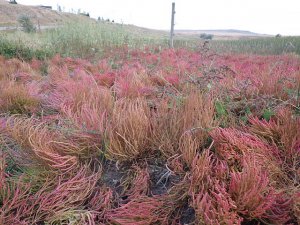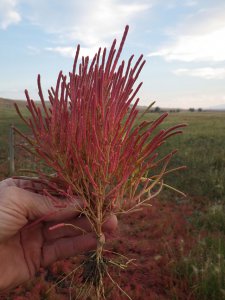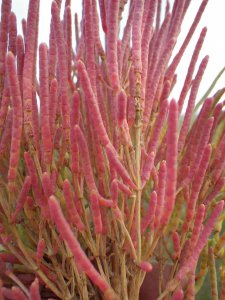What is Red Saltwort?
Salicornia rubra is a variety of saltwort plants, which are part of the Amaranth family. While not all plants that are categorized under the Amaranth family are saltwort plants, the three primary Salicornia varieties found in the United States are edible. This variety is known as red saltwort, western glasswort, or red swampfire. The plant’s name comes from the way the plant grows; red saltwort spreads across salty soils in waves of red.

Red saltwort is most often found in the central United States and select regions in Canada. States that this plant can be located include from Washington to California, and into the mid-west toward North and South Dakota. In 1984, red saltwort was unfortunately labeled as a threatened plant and has remained on the list as such since. If you have the proper environment and growing conditions available to you, it might be worth the time investment to grow a personal population of this saltwort variety.
Brief Identifiers
Unlike other forms of saltwort, the red saltwort plant is easily identifiable based on its red color. The mature plant is red and grows in large patches in salty areas, such as salt marshes. Red saltwort is an annual plant that has no flowers, with branches that are jointed. The overall height of the plant reaches between three and six inches tall. Like other varieties, red saltwort is salt tolerant and is known to be crunchy in texture, and salty in taste. Not only is saltwort salt-tolerant, but the plant also needs high-saline soils to survive, so you will not find saltwort in areas close to freshwater.

Ways to Use Red Saltwort
The most common use of saltwort plants today is culinary. Red saltwort can be harvested and used in salads, or cooked to mimic a vegetable substitute for green beans. When harvesting red saltwort, be sure to only take what you need and to pick parts from the top and outside of the plant. One way to ensure the plant parts are clean of debris and bugs is to blanch the branches. By blanching the branches in boiling water, then plunging the branches into ice water directly after, you will kill off any potentially harmful bacteria, dirt, or pests that may have latched onto the plant.
In the course of history, saltwort plants were harvested for industrial uses, such as glassmaking, hence the alternative name “western glasswort”. The branches of red saltwort would be burned, turned into ash, then the ashes were included in the process of forming glass and soap from the 16th to the 18th centuries. Once the 19th century rolled around, this formula was discontinued and saltwort was no longer harvested for industrial purposes.

The best time to harvest part for both medicinal and culinary uses is in the late summer months, to early autumn, as the color of the mature plant will be at its most vibrant. As food, the blanched branches of red saltwort can be cooked for a few minutes and used as a vegetable or can be mixed in a salad, either cooked or raw. A rarer use of red saltwort is where the branches are dried, then ground up, and turned into a powder. Since the salt content is naturally high in red saltwort, the powder can be used as a table salt alternative.
Medicinally, red saltwort, like other saltwort plants, is rich in a variety of nutrients. Minerals that can be found in red saltwort include magnesium, potassium, calcium, and sodium. Vitamins also found in this plant include vitamins A, B, and C. Because of this mix of vitamins and minerals, saltwort plants have been used to treat and ease various ailments, including rheumatism, arthritis, general aches, and pains, inflammation, and swelling.
—————Written by Jordyn Lee
Jordyn Lee is a freelance writer with a background in herbalism and a passion for sustainable living. She has a Bachelor's degree in Communication Studies and continues to learn more about health and nature. Connect with her on (LinkedIn) or Freelancer Profile (upwork.com).
Many of our readers find that subscribing to Eat The Planet is the best way to make sure they don't miss any of our valuable information about wild edibles.
See our privacy policy for more information about ads on this site






